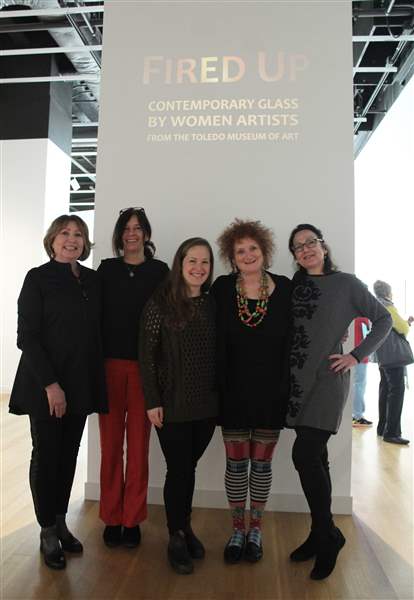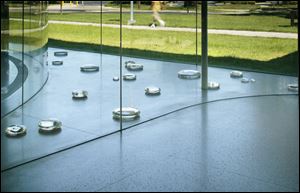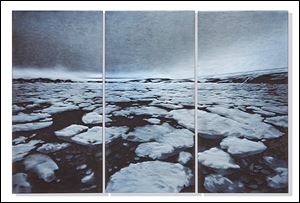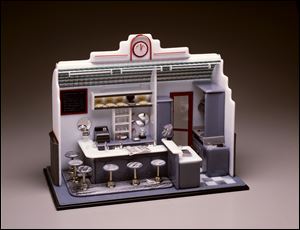
Female artists shatter glass ceiling at TMA exhibit
More than 50 pieces to be part of 'Fired Up' show
9/1/2017
Left to right Dr. Jutta Page, former senior curator of Decorative Arts and Glass at TMA, glass artists Sibelle Peretti, April Surgent, and Laura Donefer, and Annie Carlano at the Fired Up exhibition at the Mint.

Maya Lin, Dew Point 18, 2007, mold-shaped glass.
When the studio glass movement began in Toledo in the early 1960s, many artists who developed their craft in the medium were celebrated. But although women were a part of that effort, it was the men who received most of the recognition.
Fired Up: Contemporary Glass by Women Artists, an exhibition of more than 50 glass pieces from the past six decades, intends to lift that shadow and draw female glass artists back into the spotlight.
What: Fired Up: Contemporary Glass by Women Artists
When: Saturday through March 18
Where: Toledo Museum of Art’s Glass Pavilion
Details: Women studio glass artists will lead glassblowing demos and workshops offered by the Hot Shop.
Info: Events calendar at toledomuseum.org.
“Sometime, back in the day, when studio glass was young in the United States and North America, you’d hear about the men — Harvey Littleton, who started the movement, and a lot of male artists,” said Laura Donefer, a Canadian glass artist with strong ties to Toledo. “What I love about this show is women have been working in studio glass since the get-go and making really beautiful work, sensitive work, and this exhibit shows that.”
The show opens Saturday in galleries 2 and 3 of the Glass Pavilion across from the Toledo Museum of Art. It is a free show and runs through March 18.
The majority of the 56 pieces were pulled from the Toledo museum’s own collection. The exhibit was born out out of discussions between Annie Carlano, senior curator of craft, design, and fashion at the Mint Museum in Charlotte, and Jutta Page, the former senior curator of decorative arts and glass at TMA who is now executive director at Old Dominion University’s Barry Art Museum in Norfolk, Va.
“The show came out of the Mint museum celebrating its 80th anniversary and the year of the woman and looking for an exhibition of women artists,” said Paula Reich, head of interpretive projects and managing editor at TMA. “They have a small collection of contemporary glass [at the Mint] and wanted to explore that medium.”
The Mint opened both Fired Up and a second show, Women of Abstract Expressionism, when it celebrated its anniversary in October; it closed Fired Up in February. TMA is the only other venue for the show.

April Surgent, Sea Ice Moves in Spring - Arthur Harbor, Western Antarctic Peninsula, 2015, cameo-engraved glass.
Littleton, a University of Wisconsin ceramist intent on using glass as a form of expression, is credited with giving birth to the studio glass movement when he conducted glass-blowing workshops in a garage at the Toledo Museum of Art in 1962.
Dominick Labino, a Toledo-area glass researcher who gained fame during the early years of the movement, designed a furnace that was hot enough to melt the glass and created marbles that when melted could be blown into other forms by artists.
Littleton later created a glass program at the University of Wisconsin, where early students including Dale Chihuly, Marvin Lipofsky, and Fritz Dreisbach became innovators in glassblowing.
Despite the predominance of male names in history books, women have been very influential in the movement from the beginning to the present day. Many of the participants in Littleton’s workshops and glassblowing classes were women, but despite this, only seven women were among the 48 artists featured in Toledo Glass National, TMA’s first studio glass exhibition in 1966, according to Reich. By the 1990s, the number of women faculty members and students in university glass programs was equal to the number of men, she said.
"From the beginning of the history of the studio glass movement, some of the most powerful figures in the field have been women. They came on strong early in the game. As a matter of fact, glass is one of the rare fields I don't think of as predominantly male or female,” wrote Thomas Buechner, founding director of the Corning Museum of Glass in Corning, N.Y.

Emily Brock, The Counterman-Diner, 1991-1992, glass, fused, slumped, lamp worked; metal.
Forty-five female artists are featured in Fired Up, Reich said, and programming throughout the show will feature women glass artists. The show is also international in scope, she said, featuring artists from 12 different countries including Germany, Japan, Canada, and South Korea.
Donefer, who lives in Ontario, Canada, drew inspiration from her mother, who was a fiber artist, and during her early career in the 1980s, she created glass and mixed-media pieces in basket form, including a piece from her Witch Pot series that is included in the show.
She makes no apologies for her unconventional method of creating glass art that includes skulls, rocks, bones, dried plants, bits of pottery, and other things she collects from nature during her travels.
“Glass was something I started in the early ’80s, and I was new to glass then and didn’t want to make any really conventional pieces. Bowls, glasses, plates — I just wasn’t interested in any of that,” she said.
A second work by Donefer chosen by Page for the show is Blizzard Amulet Basket, 2007, an opaque white glass piece formed with cut glass and flameworked hot glass fragments.
Although the Toledo show spans 60 years of glass artistry, the studio glass movement is just getting warmed up when you consider other art media such as painting and kiln-fired ceramics that date to prehistoric or ancient eras.
“The glass movement is still very young, so I think this is a very important show,” Donefer said.
Contact Roberta Gedert at rgedert@theblade.com, 419-724-6075 or on Twitter @RoGedert.